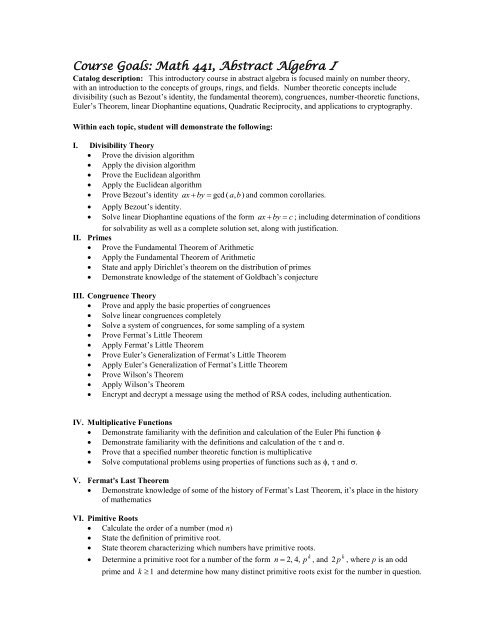Prove Fermat's Little Theorem:
Prove Fermat's Little Theorem:
Prove Fermat's Little Theorem:
- No tags were found...
You also want an ePaper? Increase the reach of your titles
YUMPU automatically turns print PDFs into web optimized ePapers that Google loves.
Course Goals: Math 441, Abstract Algebra ICatalog description: This introductory course in abstract algebra is focused mainly on number theory,with an introduction to the concepts of groups, rings, and fields. Number theoretic concepts includedivisibility (such as Bezout’s identity, the fundamental theorem), congruences, number-theoretic functions,Euler’s <strong>Theorem</strong>, linear Diophantine equations, Quadratic Reciprocity, and applications to cryptography.Within each topic, student will demonstrate the following:I. Divisibility Theory <strong>Prove</strong> the division algorithm Apply the division algorithm <strong>Prove</strong> the Euclidean algorithm Apply the Euclidean algorithm <strong>Prove</strong> Bezout’s identity ax by gcd ( a,b)and common corollaries. Apply Bezout’s identity. Solve linear Diophantine equations of the form ax by c ; including determination of conditionsfor solvability as well as a complete solution set, along with justification.II. Primes <strong>Prove</strong> the Fundamental <strong>Theorem</strong> of Arithmetic Apply the Fundamental <strong>Theorem</strong> of Arithmetic State and apply Dirichlet’s theorem on the distribution of primes Demonstrate knowledge of the statement of Goldbach’s conjectureIII. Congruence Theory <strong>Prove</strong> and apply the basic properties of congruences Solve linear congruences completely Solve a system of congruences, for some sampling of a system <strong>Prove</strong> Fermat’s <strong>Little</strong> <strong>Theorem</strong> Apply Fermat’s <strong>Little</strong> <strong>Theorem</strong> <strong>Prove</strong> Euler’s Generalization of Fermat’s <strong>Little</strong> <strong>Theorem</strong> Apply Euler’s Generalization of Fermat’s <strong>Little</strong> <strong>Theorem</strong> <strong>Prove</strong> Wilson’s <strong>Theorem</strong> Apply Wilson’s <strong>Theorem</strong> Encrypt and decrypt a message using the method of RSA codes, including authentication.IV. Multiplicative Functions Demonstrate familiarity with the definition and calculation of the Euler Phi function Demonstrate familiarity with the definitions and calculation of the and . <strong>Prove</strong> that a specified number theoretic function is multiplicative Solve computational problems using properties of functions such as , and .V. <strong>Fermat's</strong> Last <strong>Theorem</strong> Demonstrate knowledge of some of the history of Fermat’s Last <strong>Theorem</strong>, it’s place in the historyof mathematicsVI. Pimitive Roots Calculate the order of a number (mod n) State the definition of primitive root. State theorem characterizing which numbers have primitive roots.k Determine a primitive root for a number of the form n 2, 4,p , andk2 p , where p is an oddprime and k 1and determine how many distinct primitive roots exist for the number in question.
VII. Introduction to groups Define group, order of a group and order of an element of a group.Z n modn U n , modn . Define the groups , and Determine order of the groups Z n , modn and U n modn elements of such groups. Determine generators for Z n , modn and U n modn , , and the order of specified, , in the case that the group is cyclic.VIII. Computation Explore number theoretic calculations on a hand-held calculator and demonstrate knowledge ofthe limits and reliability of this tool. Use a CAS, such a Mathematica, to explore a number theory problems that exceed the capacity ofa hand-held calculator, such as RSA encryption examples.IX. Quadratic Reciprocity Demonstrate knowledge of and be able to prove the basic properties of the Legendre symbol Demonstrate knowledge of the statement of and be able to apply the law of quadratic reciprocity Demonstrate knowledge of and be able to prove which primes have –1 as a quadratic residue



